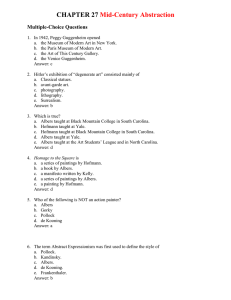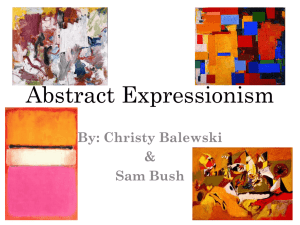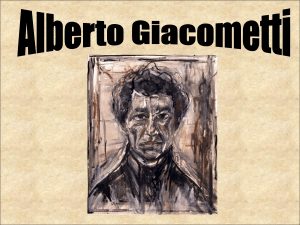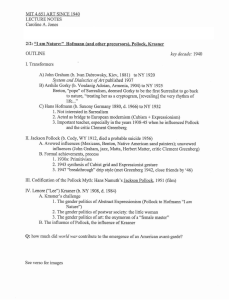Arshile Gorky
advertisement
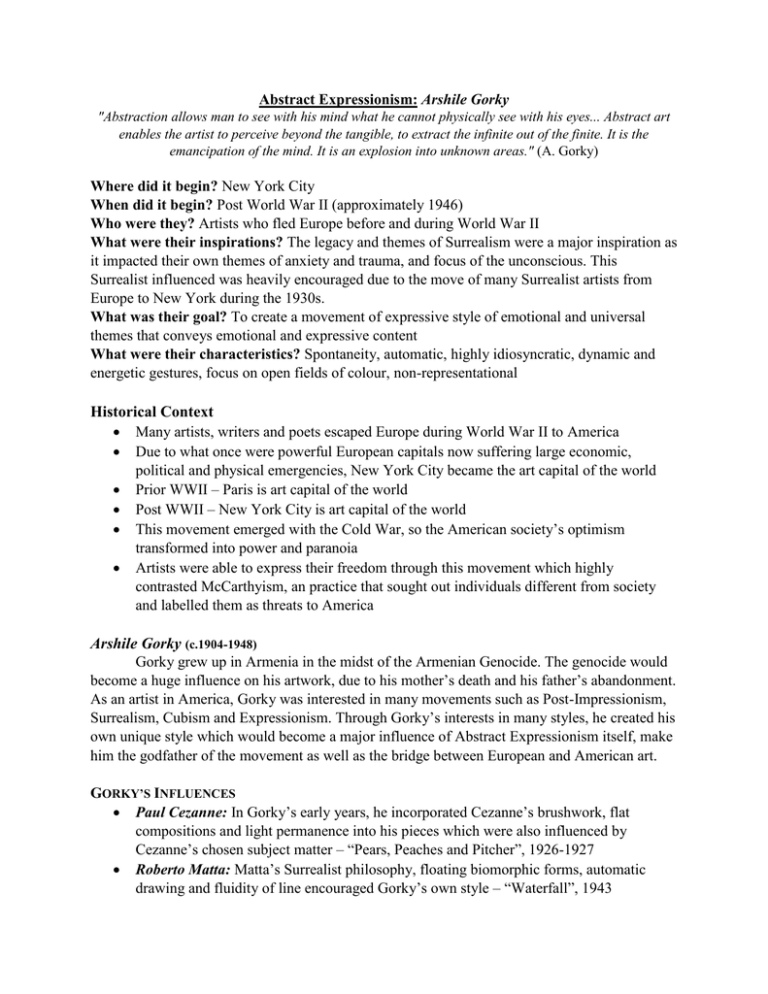
Abstract Expressionism: Arshile Gorky "Abstraction allows man to see with his mind what he cannot physically see with his eyes... Abstract art enables the artist to perceive beyond the tangible, to extract the infinite out of the finite. It is the emancipation of the mind. It is an explosion into unknown areas." (A. Gorky) Where did it begin? New York City When did it begin? Post World War II (approximately 1946) Who were they? Artists who fled Europe before and during World War II What were their inspirations? The legacy and themes of Surrealism were a major inspiration as it impacted their own themes of anxiety and trauma, and focus of the unconscious. This Surrealist influenced was heavily encouraged due to the move of many Surrealist artists from Europe to New York during the 1930s. What was their goal? To create a movement of expressive style of emotional and universal themes that conveys emotional and expressive content What were their characteristics? Spontaneity, automatic, highly idiosyncratic, dynamic and energetic gestures, focus on open fields of colour, non-representational Historical Context Many artists, writers and poets escaped Europe during World War II to America Due to what once were powerful European capitals now suffering large economic, political and physical emergencies, New York City became the art capital of the world Prior WWII – Paris is art capital of the world Post WWII – New York City is art capital of the world This movement emerged with the Cold War, so the American society’s optimism transformed into power and paranoia Artists were able to express their freedom through this movement which highly contrasted McCarthyism, an practice that sought out individuals different from society and labelled them as threats to America Arshile Gorky (c.1904-1948) Gorky grew up in Armenia in the midst of the Armenian Genocide. The genocide would become a huge influence on his artwork, due to his mother’s death and his father’s abandonment. As an artist in America, Gorky was interested in many movements such as Post-Impressionism, Surrealism, Cubism and Expressionism. Through Gorky’s interests in many styles, he created his own unique style which would become a major influence of Abstract Expressionism itself, make him the godfather of the movement as well as the bridge between European and American art. GORKY’S INFLUENCES Paul Cezanne: In Gorky’s early years, he incorporated Cezanne’s brushwork, flat compositions and light permanence into his pieces which were also influenced by Cezanne’s chosen subject matter – “Pears, Peaches and Pitcher”, 1926-1927 Roberto Matta: Matta’s Surrealist philosophy, floating biomorphic forms, automatic drawing and fluidity of line encouraged Gorky’s own style – “Waterfall”, 1943 Pablo Picasso: Gorky wanted to mimic the Cubist and Surrealist qualities Picasso possessed within his artworks, as well as his form and colour – “Woman with a Palette”, 1927 Joan Miro: Gorky experimented with Miro’s Surrealist qualities, biomorphic shapes floating on a melting background, reduction of details in his subjects, palette and form – “Garden in Sochi”, 1943 GORKY’S CHARACTERISTICS References to Armenia, specifically the Armenian Genocide Biomorphic forms in strong colours Unrecognizable shapes with personal meaning Layered Abstract elements floating in congested space Energetic line Translucent Evocative ARTWORKS o “The Liver is the Cock’s Comb”, 1944: Biomorphic forms in strong colours are congested and floating in space Shapes are so abstracted and personal that their meaning is unknown The colours of the shapes are layered overtop one another to create translucency This painting is said to represent the perfectly ordered world he lived in before the wild and savage world destroyed it, which could reference to the atrocities in Armenia The liver is said to be the seat of love and lust, so this painting can also be taken as a statement that life is vanity and vain The “cock’s comb” doubles as headdress and phallic symbol to create a link between the mind and body o “Agony”, 1947: Unrecognizable symbolism in extremely personal biomorphic shapes Translucent and layered colours within his forms Depicts the agony Gorky endured during the last two years of his life Figure in the left represents Gorky who is painted in fiery colours and pulled at by lines to create the feeling of suffering, pain and sorrow Death is represented in malleable forms o “The Artist and His Mother”, 1926-1936 Biomorphic forms beginning to form in the figures Extremely evocative as it references to his experiences in the Armenian Genocide Inspired by a picture taken of him and his mother in Armenia Certain elements reference to the pain of her death: space between him and his mother, his feet motioning away from her and the cloth is similar to that of Mother Mary to make her an immortal icon Inspiration is drawn from Picasso’s Blue Period IMPORTANCE IN ART HISTORY Gorky was a major influence on the movement of Abstract Expressionism Through his work, he helped establish New York City as not only the art capital of the world but also the cultural capital of the post war world Gorky’s method of assembling compositions, which was both spontaneous and planned, and his focus on the painting process became popular amongst Abstract Expressionist, such as De Kooning and Pollock Since his influence was so substantial on the next two generations of artists, his art hangs in every major American art museums Gorky influenced numerous artists such as Johns, Rauschenberg, De Kooning, Rosenberg and Greenberg


